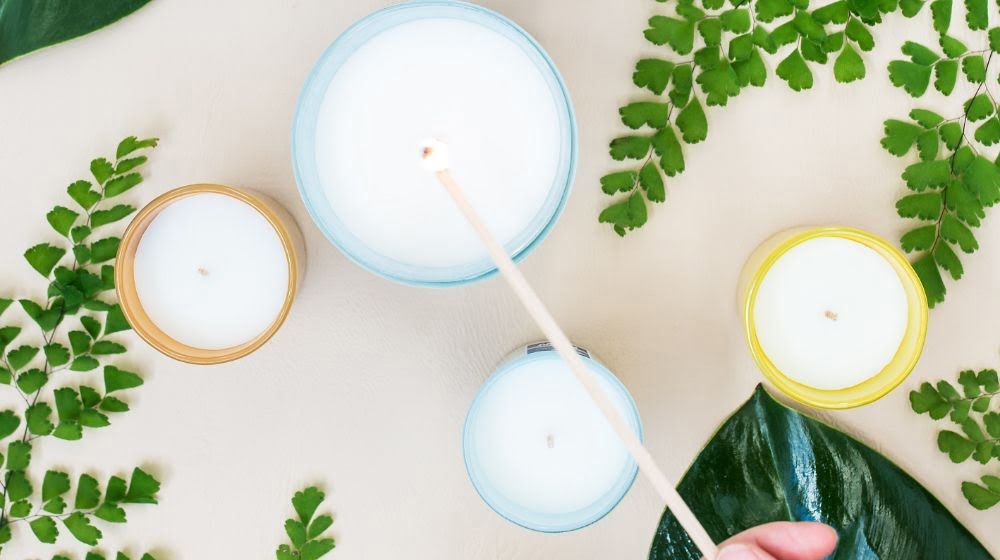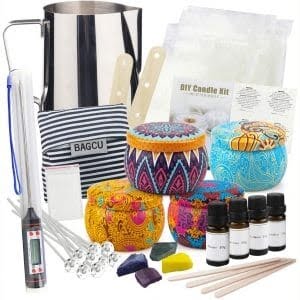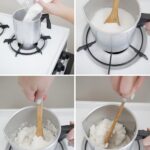Whether you’re a seasoned candle maker or just starting out on your crafty journey, understanding the importance of wick rope is essential. In this article, we will delve into the world of wick ropes, exploring their magical qualities and how they play a vital role in the candle-making process. From enhancing burning efficiency to improving overall quality, choosing the right wick rope can make all the difference in creating beautifully crafted candles that light up any space.
Candle making has been an age-old tradition that spans across cultures and civilizations. With advancements in technology and materials, the choices for wick ropes have become more diverse than ever before.
In this article, we will not only explore the different types of wick ropes available in the market but also provide valuable insights into their advantages and disadvantages. Whether you prefer cotton, hemp, or wood wicks, understanding their unique characteristics is crucial in achieving the desired ambiance and burn rate for your candles.
But before we dive into the specifics of wick ropes and their selection process, let’s take a moment to appreciate the historical significance of these essential components. Wick ropes have been used for centuries to bring light into people’s lives.
Throughout history, different cultures and civilizations have experimented with various materials to create their own versions of wick ropes. By tracing back their origins, we can gain a deeper appreciation for this timeless tradition and its evolution over time.
So join us on this journey as we uncover everything there is to know about wick rope for making candles – from its historical roots to advanced techniques and troubleshooting tips. By harnessing the power of knowledge, you’ll be able to create perfectly crafted candles that not only illuminate your surroundings but also ignite your creativity. Let’s explore the magic of wick rope together.
Understanding the Importance of Choosing the Right Wick Rope for Candle Making
Choosing the right wick rope is crucial in the candle-making process as it plays a vital role in determining the burning efficiency and quality of candles. Understanding the importance of selecting the appropriate wick rope is essential for achieving desired results and ensuring a satisfactory candle-burning experience.
One of the key aspects to consider when choosing a wick rope is its compatibility with the type and size of candles being made. The burn rate, candle diameter, and desired ambiance are all factors that can influence which wick rope to use.
For instance, a larger, wider candle may require a thicker and sturdier wick rope to provide sufficient heat and ensure an even burn. On the other hand, smaller, narrower candles may need thinner wicks to prevent an overpowering flame that can lead to excessive melting or uneven burning.
Another factor to consider is the material used for the wick rope. There are various types available in the market, including cotton, hemp, and wood wicks. Each material has its own advantages and disadvantages.
Cotton wicks are commonly used due to their affordability, accessibility, and ability to create a steady flame. Hemp wicks are known for their clean burning properties and suitability for larger candles. Wood wicks offer a unique crackling sound while burning but may require more maintenance compared to other materials.
A Brief History
Origins of Wick Ropes
The use of wick ropes in candle making can be traced back to ancient civilizations. The earliest known evidence of candle making dates back to ancient Egypt, where Egyptians used papyrus reeds as the wick for their candles. These reeds were soaked in beeswax or tallow to create a slow-burning and long-lasting flame.
Throughout history, different cultures and civilizations have experimented with various materials to create wicks for candles. In ancient Rome, for example, rushlights were commonly used as wicks. These rushlights were made from the pith of the rush plant, soaked in animal fat or tallow. Similarly, in Japan, the use of washi paper strips as wicks became popular during the Edo period.
Diversity in Materials
As candle making evolved over time, so did the materials used for wick ropes. Different materials offer varying burn rates and characteristics that can affect the performance and quality of candles.
One of the most common materials used for wicks is cotton. Cotton wicks are versatile and widely available, making them a popular choice among candle makers. They provide a steady and even burn, making them suitable for various candle sizes and types.
Hemp wicks have also gained popularity due to their natural properties and sustainability. Hemp wicks offer a slower burn compared to cotton wicks, allowing candles to last longer.
In recent years, wood wicks have emerged as an innovative alternative to traditional cotton or hemp wicks. These wicks are made from sustainably sourced wood and offer a unique crackling sound reminiscent of a cozy fireplace.
Cultural Influences
The choice of material for wick ropes has often been influenced by cultural practices and traditions associated with candle making. For example, in India, religious ceremonies often involve the use of ghee lamps called “diyas,” which are lit with a cotton wick. In Scandinavian countries, the use of wooden wicks is popular as it creates a warm and rustic ambiance.
Understanding the historical background of wick ropes not only allows candle makers to appreciate the roots of their craft but also provides insight into the versatility and diversity the art of candle making offers today.
Types of Wick Ropes
An Overview of Different Types of Wick Ropes
When it comes to candle making, choosing the right wick rope is crucial to achieve optimal burning efficiency and quality. There are various types of wick ropes available in the market, each with its own unique set of advantages and disadvantages. Understanding the differences between these options can help you make an informed decision when selecting the perfect wick rope for your candles.
Cotton Wick Ropes
Cotton wick ropes are one of the most commonly used types in candle making. They are known for their affordability, reliability, and wide availability. Cotton wicks provide a clean burn and are suitable for both container candles and pillars.
However, it’s essential to choose a cotton wick that is properly sized for your candle’s diameter to ensure an even burn. Cotton wicks do tend to produce a larger flame compared to other materials, so they work particularly well in larger candles or those with higher fragrance loads.
Hemp Wick Ropes
Hemp wick ropes have gained popularity among candle makers due to their eco-friendly nature. Made from natural hemp fibers, these wicks offer a slow burn rate and a minimal carbon build-up. Hemp wicks are often used in beeswax candles as they complement the natural scent and appearance of the wax. However, it’s important to note that hemp wicks require regular maintenance, such as trimming the burnt end before relighting.
Wood Wick Ropes
Wooden wick ropes have become increasingly popular in recent years due to their unique crackling sound and aesthetic appeal. These wicks are typically made from sustainably sourced wood such as cherry or birch. Wood wicks offer an excellent burn performance with little to no mushrooming or soot formation.
They are particularly suited for soy-based and gel candles but can also be used in other types. Keep in mind that wood wicks require a longer initial burn time compared to other wicks to establish a good wax pool.
Considerations When Choosing Wick Rope
When selecting the right wick rope for your candles, several factors should be taken into consideration. The burn rate, candle diameter, and desired ambiance all play a crucial role in determining the appropriate wick rope.
Consider the burn rate of your chosen wick rope in relation to your candle’s size. A slower-burning wick may be suitable for larger candles or those with thicker walls, while a faster-burning wick is better suited for smaller or narrower candles. Additionally, consider the type of wax you are using and how it interacts with different materials.
The candle diameter is also an important factor when selecting a wick rope. A proper fit is necessary to ensure an even burn. It’s generally recommended to choose a wick that is around one-third of the candle’s diameter for optimal performance.
Lastly, consider the desired ambiance you want to create with your candles. Different wick ropes can produce various flame heights and sizes, which can significantly impact the overall atmosphere. Experimenting with different types of wicks can help you achieve your desired aesthetic and burning experience.
Understanding the diversity of wick ropes available and taking these considerations into account will empower you to choose the perfect option for your candle-making endeavors. Whether you prefer the affordability of cotton, eco-friendliness of hemp, or unique crackling sound of wood, there’s a wide range of choices available to suit your preferences and achieve beautifully crafted candles.
Factors to Consider
When it comes to making candles, choosing the right wick rope is essential for achieving optimal burning efficiency and high-quality candles. There are several factors that need to be considered when selecting wick ropes for different candle types and sizes. By carefully considering these factors, you can make an informed decision and create candles that not only burn well but also create the desired ambiance.
One important factor to consider is the burn rate of the wick rope. This refers to how quickly the wick consumes the fuel and determines how long your candle will last. Different wick ropes have different burn rates, so it’s important to choose one that matches your desired burn time. For example, if you want a long-lasting candle, you may opt for a wick rope with a slower burn rate.
Another factor to consider is the diameter of your candle. The size of the wick rope should be appropriate for the diameter of your candle. If the wick is too thick for a small candle, it may produce too much heat and cause melting or tunneling.
On the other hand, if the wick is too thin for a large candle, it may not provide enough heat for an efficient burn. It’s important to find the right balance between wick thickness and candle diameter.
Additionally, consider the type of ambiance you want to create with your candles. Some wick ropes produce a bright flame that creates a vibrant atmosphere, while others produce a softer flame that creates a cozy and intimate ambiance. Consider the purpose of your candles and choose a wick rope that complements that purpose.
DIY Wick Ropes
Creating your own homemade wick ropes is a fun and rewarding way to enhance your candle-making experience. Not only can you customize the length and thickness of the wicks, but you also have the freedom to experiment with different materials for unique effects. In this section, we will provide you with a step-by-step guide on how to make homemade wick ropes.
Materials
To get started, gather the following materials:
– Natural fibers such as cotton yarn or hemp twine (avoid synthetic materials as they may release toxins when burned).
– Beeswax or soy wax for coating the wick rope.
– Scissors.
– Clothespins or something similar to hold the wick rope while it dries.
Step 1: Cut the Wick Rope
Start by determining how long you want your wick rope to be and cut a piece of cotton yarn or hemp twine accordingly. It’s recommended to add an extra inch or two for easier handling.
Step 2: Soak in Wax
Next, prepare a container with melted beeswax or soy wax. Dip the cut piece of cotton yarn or hemp twine into the melted wax, making sure it is fully submerged. Allow it to soak for a few minutes.
Step 3: Dry and Coat Again
After soaking, take out the wick rope from the wax container and let any excess wax drip off. Hang it using clothespins or lay it on a clean surface to dry. Once it is dry, repeat the soaking process one more time for a thicker coat of wax.
Step 4: Trim and Store
Once your homemade wick rope is completely dry, trim off any stray fibers or uneven edges. Your homemade wick rope is now ready to use. You can store them in an airtight container or wrap them around a spool for easy access.
Making your own wick ropes not only allows you to customize the size and material but also ensures that you have control over the quality and safety of your candles. Experiment with different materials and lengths to find what works best for your candle-making projects. Enjoy the process of crafting your own wick ropes, and let your creativity shine through in every candle you make.
| Materials |
|---|
| Natural fibers (cotton yarn or hemp twine) |
| Beeswax or soy wax |
| Scissors |
| Clothespins (or something similar) |
Advanced Techniques
In the world of candle making, there is an artistry that goes beyond simply pouring wax into molds. One of the ways to elevate your candle making experience and create truly unique and exceptional candles is by exploring innovative wick rope designs. These designs not only enhance the aesthetics of your candles but also contribute to their overall performance.
Twisted wick ropes are a popular choice among candle makers looking for a touch of elegance and sophistication in their creations. These wicks are made by twisting multiple strands of cotton or hemp together, resulting in a visually appealing spiral pattern. The twisted design allows for increased fuel absorption, ensuring a steady and even burn throughout the entire life of the candle.
Braided wick ropes offer another exciting option for candle enthusiasts looking to add a touch of intricacy to their creations. Made by weaving several strands of cotton or hemp together, braided wicks provide enhanced stability and rigidity. This design allows the wick to stand upright in molten wax, preventing it from falling over or extinguishing prematurely.
Specialty wicks are yet another avenue for creative expression in candle making. These unique designs include ribbon wicks, crackling wood wicks, and even self-trimming wicks. Ribbon wicks provide a beautiful ribbon-like flame that dances atop the wax pool, creating an enchanting ambiance.
Crackling wood wicks add an extra sensory element with their gentle crackling sound reminiscent of a cozy fireplace. Self-trimming wicks have a built-in mechanism that curls the spent portion of the wick into the flame as it burns, reducing carbon buildup and eliminating the need for trimming.
By experimenting with these innovative designs, candle makers can not only create visually stunning candles but also enhance their overall performance and appeal. Whether you choose a twisted, braided, or specialty wick rope design, such variations will elevate your candle-making experience to new heights. Don’t be afraid to get creative, and let your imagination run wild as you explore the possibilities of wick rope designs in candle making.
| Design | Description |
|---|---|
| Twisted Wick Ropes | Made by twisting multiple strands of cotton or hemp together, these wicks provide a visually appealing spiral pattern. They ensure a steady and even burn throughout the life of the candle. |
| Braided Wick Ropes | Weaved by intertwining several strands of cotton or hemp, braided wicks offer enhanced stability and rigidity. They stand upright in molten wax, preventing premature extinguishing. |
| Specialty Wicks | Ribbon wicks create a ribbon-like flame; crackling wood wicks produce gentle crackling sounds, and self-trimming wicks curl the spent portion into the flame as they burn. |
Troubleshooting
Candle making can be a fulfilling and enjoyable hobby, but like any craft, it can come with its share of challenges. One common issue that candle makers often encounter involves problems with the wick rope. Fortunately, there are solutions to address these issues and ensure a smooth burning experience for your candles.
One of the most common problems that arise with wick ropes is a phenomenon called “tunneling.” This occurs when the wax around the wick does not melt evenly, resulting in a tunnel-like hole down the center of the candle.
To prevent tunneling, it is crucial to choose wick ropes that have a suitable diameter for your candle. A wick that is too small will not create enough heat to melt the surrounding wax, while a wick that is too large will produce an excessive amount of heat and cause uneven melting.
Another issue that candle makers may face is “mushrooming,” which refers to the formation of a mushroom-shaped carbon ball on the tip of the wick after burning. Mushrooming can lead to excessive smoke, soot, and poor scent throw in your candles. To avoid this problem, it is recommended to trim the wick to an appropriate length (usually around ¼ inch) before each use. Trimming the wick helps control the size of the flame and prevents excess carbon buildup.
Additionally, some candle makers may notice their candles extinguishing themselves or producing weak flames during burning. This could be due to using wicks that are not properly primed or coated with enough wax. Wick primers are available in the market and can help improve burn performance by creating an even flow of fuel up the wick. Applying a layer of melted wax over your wicks before pouring your candle mixture can also aid in better combustion.
Conclusion
In conclusion, it is evident that the choice of wick rope plays a crucial role in the overall quality and efficiency of candle burning. Throughout history, wick ropes have evolved and been crafted from various materials by different cultures, highlighting their importance in the art of candle making. Today, there are numerous types of wick ropes available in the market, each with its advantages and disadvantages.
When selecting the right wick rope, it is essential to consider factors such as burn rate, candle diameter, and desired ambiance. By taking these factors into account, candle makers can create candles that burn evenly and emit the desired amount of fragrance. Furthermore, embarking on the journey of making homemade wick ropes opens up a realm of creativity and customization possibilities.
Additionally, advanced techniques such as twisted or braided wick ropes can elevate the aesthetics and performance of candles. These unique designs add an artistic touch to candles while ensuring efficient burning. However, it is important to address any common issues that may arise during the candle-making process involving wick ropes. By troubleshooting common challenges and following safety guidelines, candle makers can ensure a smooth burning experience for their creations.
In conclusion, by harnessing the power of the right wick rope, candle makers can craft perfectly crafted candles that enhance any space’s ambiance. Whether using commercially available options or venturing into DIY projects at home, understanding the significance of selecting the right wick rope ensures optimal results.
With this newfound knowledge gained from this article’s exploration into wick ropes for making candles, readers are encouraged to embark on their own candle-making journey to create beautiful and aromatic masterpieces that light up their homes or delight others as heartfelt gifts.

Welcome to my candle making blog! In this blog, I will be sharing my tips and tricks for making candles. I will also be sharing some of my favorite recipes.





